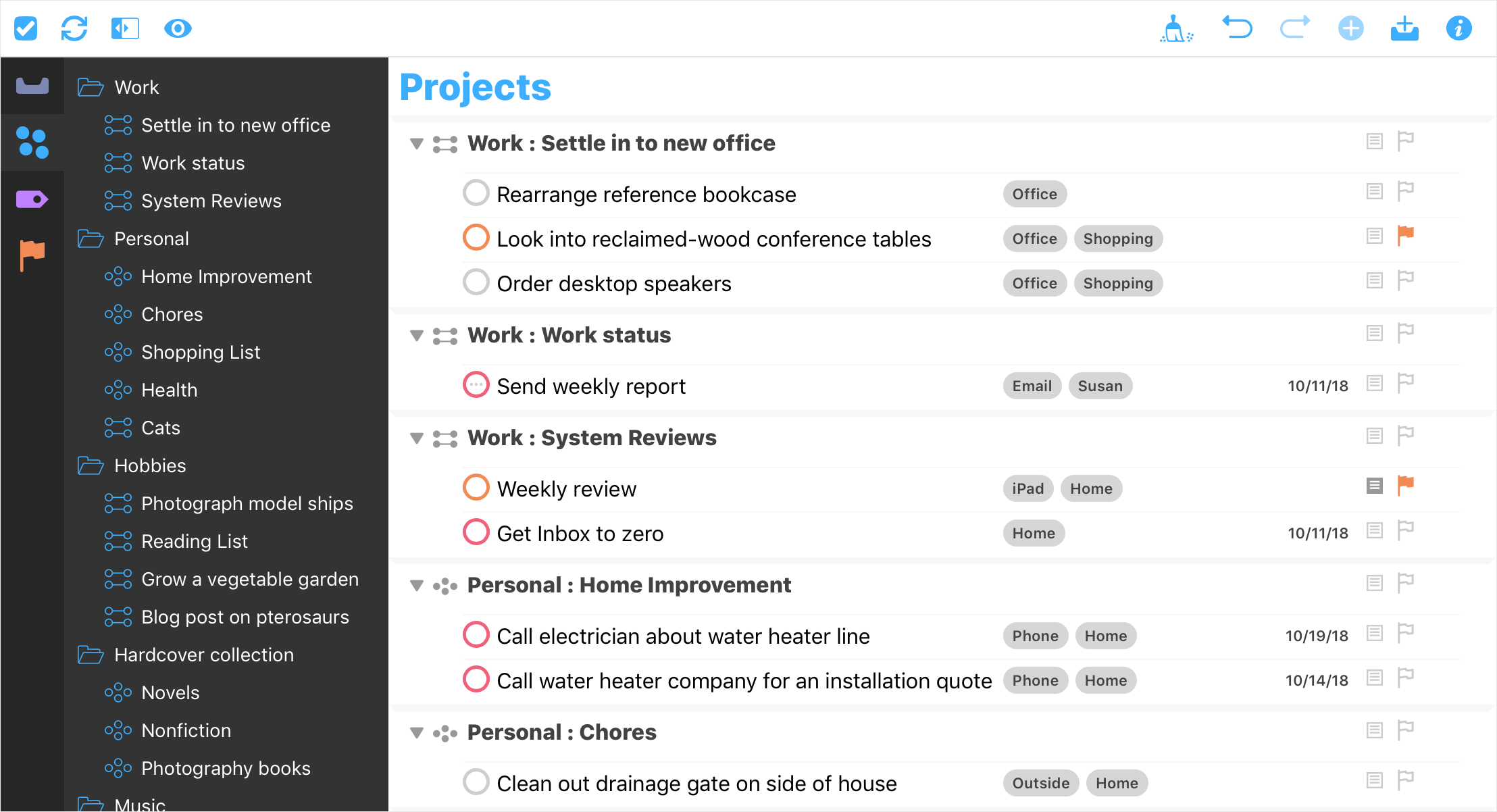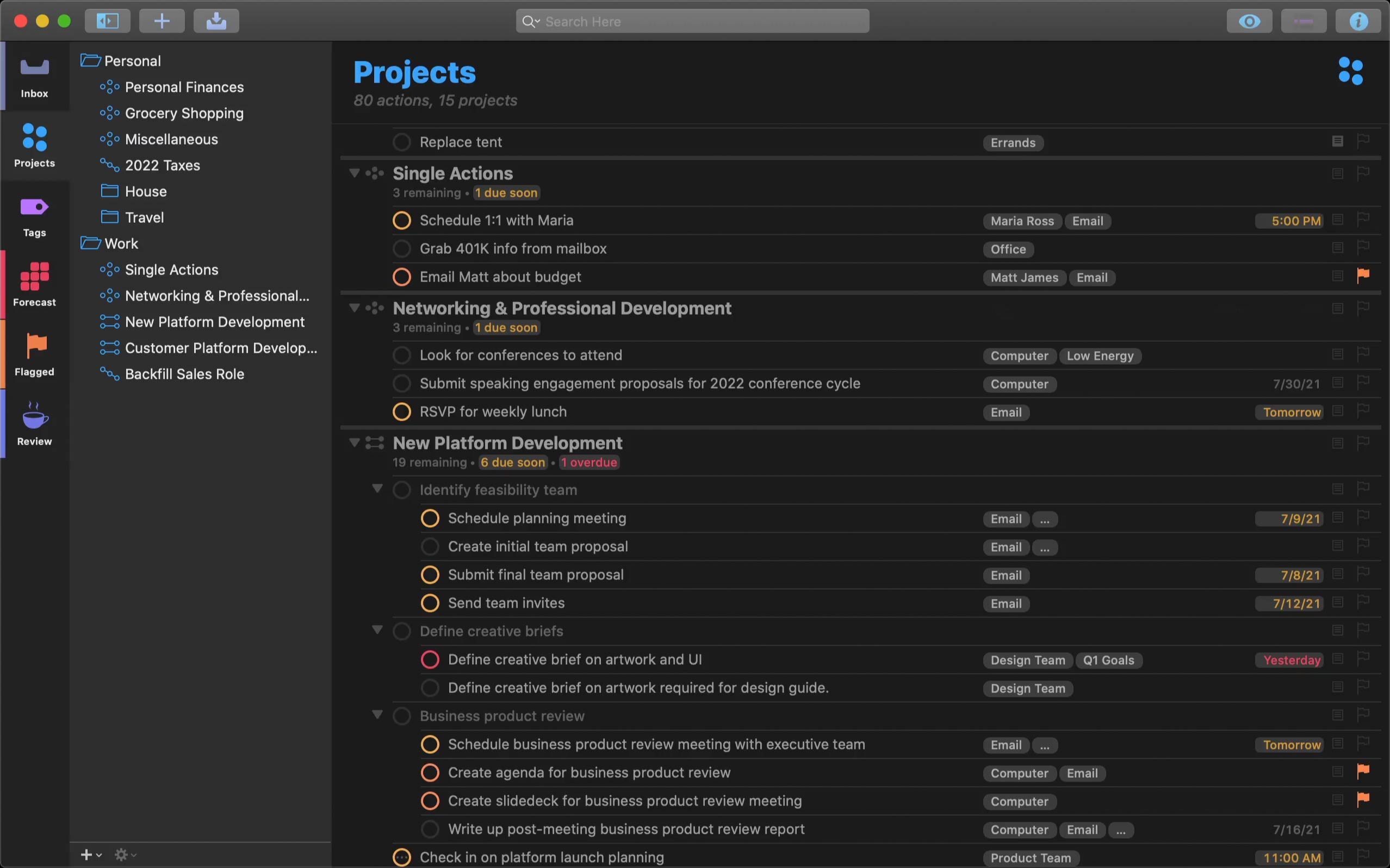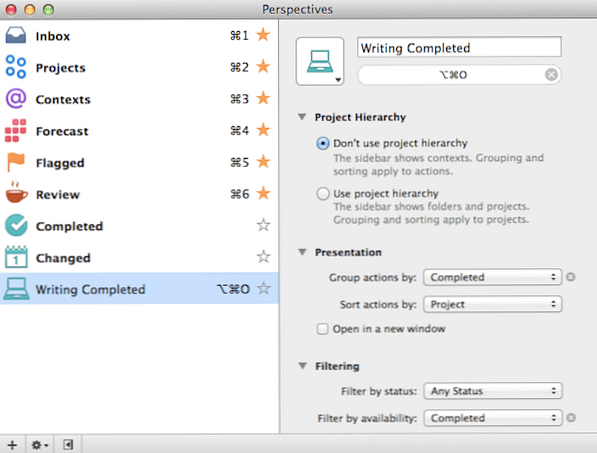As of version 2.20 (Released July 26, 2017) OmniFocus 2 for iOS is a free download in the App Store, with the Standard and Pro feature sets available via In-App Purchase. We also offer a 14-day free trial, after which OmniFocus will function as a free viewer.
The purchase options available to you are based upon your purchase history. If you own a previous version of OmniFocus for iPad or iPhone, you can purchase Pro or Standard in v2 at a discount. If you start with Standard and decide you want Pro later, you can upgrade for the difference in cost.

Start by downloading OmniFocus 2 from the App Store. This article walks you through the purchase process you’ll take after opening the new version, as well as the different upgrade options you may have.
Starting your Trial
The first time you open OmniFocus, you’ll see a short video on using the app. After you’ve watched it, tap Unlock OmniFocus at the bottom of the page to open the In-App Purchases area. At the top of the In-App Purchases area you’ll see the Free Trial option; select it and then tap the Start Trial button to confirm and begin the free trial. There’s no purchase necessary to start this trial, and your credit card will not be automatically charged for either the Standard or Pro feature sets when the trial period expires.
Our desktop apps are sold through two separate channels: Apple’s Mac App Store. Mac App Store apps fall under Apple’s Terms & Conditions, and are licensed directly through the individual user’s Mac App Store account. Purchase and download OmniFocus 2 from the App Store. There’s only one download for both Pro and Standard users; we’ll unlock the Pro features in the next step. Open OmniFocus 2 and choose In-App Purchase from the OmniFocus application menu. In the window that opens, select the Pro Upgrade (with discount for prior purchase) option. OmniFocus 2’s most important advantage is its rich and customizable functionality, especially in the Pro version, which includes the ability to adjust core structural elements: Custom Perspectives: Default “perspectives” — like an “Area” in Things — ship with the standard OmniFocus 2 app, but you can create custom ones.
During your trial, a bar at the bottom of the screen lets you know how much time is left. You can switch between Pro and Standard feature sets using the switch in OmniFocus Settings.
Accessing the In-App Purchases area
You’ll find the In-App Purchases area near the top of OmniFocus Settings. To find it from the OmniFocus 2 Home screen, swipe down to reveal the Settings button and tap it.
If you already own an earlier version of OmniFocus for iPad or iPhone, follow the remaining steps in the section titled Upgrade Pricing for existing customers. Otherwise, follow steps in the section titled Unlocking OmniFocus for new users below.
Unlocking OmniFocus for new users
When you’re ready to purchase OmniFocus 2, tap Unlock Standard or Unlock Pro in the In-App Purchases area of Settings, then tap Buy Now and confirm with your Apple ID to complete your purchase.
You’ll receive a confirmation prompt letting you know the purchase was successful. If you have any other devices to install OmniFocus 2 on, use the Restore Purchase button in the In-App Purchases area in OmniFocus Settings on your other device to activate the same feature set elsewhere. Thanks for purchasing OmniFocus 2–you’re now ready to get to work!
Upgrade pricing for existing customers
Thanks for being an existing customer! If you’ve purchased an earlier version of OmniFocus, you may be eligible for a discount when upgrading to Pro or Standard in OmniFocus 2. In order to receive your discount, OmniFocus 2 for iOS and the earlier version will both need to be installed on your device.
Make sure the earlier version of OmniFocus is installed on your iOS device. If you need to reinstall, follow the steps in the section titled Reinstalling an older version below.
If you haven’t already, download OmniFocus 2 for iOS via the App Store and open it. Open OmniFocus Settings and find the In-App Purchases area.
If OmniFocus successfully validates the earlier version that’s installed, the text box below the upgrade options will confirm that an upgrade discount is being applied, and discounted In-App Purchase options will be shown above. If an earlier version is installed but the text doesn’t mention a discount, tap Check for Discount to manually verify discount eligibility.
When you’re ready to purchase the upgrade, tap the Upgrade to v2 Standard or Upgrade to v2 Pro option, then tap Buy Now and confirm with your Apple ID to complete your purchase.
You’ll receive a confirmation prompt letting you know the purchase was successful. If you have any other devices to install OmniFocus 2 on, use the Restore Purchase button in the In-App Purchases area of OmniFocus Settings on your other device to activate the same feature set elsewhere. Thanks for purchasing OmniFocus 2, and for your continued support!
Restoring purchases
After the initial In-App Purchase is completed, that purchase is permanently associated with your Apple ID. As long as you are using the same Apple ID and are in the same country as the original purchase, Apple allows you to re-download any of your previous purchases for free.
If you’d like to activate Standard or Pro on any of your other iOS devices, or if you’ve performed an iOS restore and have wiped everything off your device, then head back to this In-App Purchases area in OmniFocus Settings and tap the Restore Purchase button. This reactivates your previous In-App Purchase, so you don’t need to purchase everything all over again.
Reinstalling an older version
The validation process for an upgrade discount requires you to have an earlier version of OmniFocus installed. That’s great news if you’ve still got the app on your device, but what if you’ve removed it already?
If we don’t detect the previous version of the app, when you tap the Check for Discount button you’ll be asked to re-download it from the App Store.
Any time you make a purchase in the App Store, that purchase is tied to your Apple ID. As long as you are using the same Apple ID and are in the same country as the original purchase, Apple allows you to re-download any apps you’ve previously paid for, free of charge.
Earlier versions of OmniFocus have been removed from sale, but remain available for reinstallation from the App Store’s Purchased section. More information about accessing the Purchased section is available on Apple’s support site here.
After the previous version is reinstalled, proceed with the remaining steps in the Upgrade Pricing for existing customers section. When successful, we’ll tell you that you’re eligible and you can then tap the discounted upgrade options to proceed with your purchase.
Troubleshooting

Omnifocus Projects Vs Tags
If you are unable to reinstall the previous version, try logging out and logging back in to the App Store.
Go into the device “iTunes & App Store” settings
Log out of your Apple ID
Log back in with your Apple ID (be sure to use the ID tied to your purchase of the previous version)
Try reinstalling the previous version.
Do I need to keep both versions installed?
We expect most users to remove the earlier version after setting up OmniFocus 2, but it’s safe to leave both installed simultaneously if you prefer. The different versions of OmniFocus won’t directly interfere or interact with each other, but it might make things more confusing since it’s hard to tell the versions apart by icon alone. If you do decide to uninstall the earlier version, make sure your data’s all loaded into OmniFocus 2 first.
Last Modified: Jan 29, 2020Arkus, Inc. is a 100% GTD® company, and we use OmniFocus Pro for Mac and iOS as the corporate standard to successfully manage thousands of internal and external projects. Here is how we do it.
Building a Better Business
Omnifocus For Pc
I am one of the co-founders of Arkus, a Salesforce consulting partner since 2010. In the last eight years, we have grown from just three founders to a team of over thirty, completing over a thousand external projects for more than 400 clients. One of the not-so-secret keys to our success is building the company and culture on the core tenets of Getting Things Done® (GTD®) — and using OmniFocus Pro for productivity.
At Arkus it’s our job to bring success to our clients, and one of our core principles in doing so is productivity. When we founded Arkus, the other two co-founders and I were already practitioners of David Allen’s GTD®, so when we hired our first summer intern, it felt only natural to hand him a copy of the book and suggest he read it.
As the team grew over the years, we started building GTD® and OmniFocus more and more into our practices and procedures. First we provided the software, and then built it into the onboarding process. Later we implemented recorded workshops and help sessions to embrace the practice, and to slowly build it into a skill.
Omnifocus Subscription
Training The Team in OmniFocus Pro
Today every new employee is given a copy of Getting Things Done®, along with a license for the latest release of OmniFocus Pro on both Mac and iOS. New “Arkies,” as we call them, are asked to read the book as one of their very first onboarding tasks. Soon after, they begin to practice the methods outlined in the book by capturing and managing commitments in OmniFocus, synchronizing across their devices with Omni Sync Server.
OmniFocus Pro is a corporate standard, alongside G Suite for calendaring and email and Salesforce for CRM. We run a training program called Arkus Boot Camp (ABC) to get people up to speed, which includes hundreds of tasks to test and improve each trainee’s consulting, Salesforce, and project management skills. GTD® and OmniFocus play a large part in ABC. I personally host initial one-on-one sessions to introduce the tool and offer individual coaching as employees get up to speed. While some are overwhelmed when they first pick up GTD® or first open OmniFocus, many come to embrace and maintain the practice even beyond Arkus. Since everyone uses Omni Sync Server, they can take their GTD® practice with them when they leave.
Omnifocus Pro Vs Standard
Smarter Tools and Task Management
Arkus is a distributed company where employees work all over the country, so keeping a community culture, as well as having a place to go for information, is very important. We have a GTD® Slack channel where we discuss OmniFocus tips and host periodic workshops, to keep everyone up to speed on newly released OmniFocus features. Since everyone is an OmniFocus user, employees can collaborate and lean on each other for quick answers or tips. We have also built a living document in Google Docs to capture OmniFocus tricks, tips, and updates, and as a place to start. Ask a question in Slack, get a great answer, and pay the #QuestionTax by adding it to the document.
Since everyone uses the same tools, all our internal process documentation refers to creating projects and tasks in OmniFocus, bolstered by screenshots and examples. Our experience is that GTD® is easier to implement if everyone is using the same tool.
I often make the analogy of being at a company where everyone uses a different calendaring system or a different CRM; both, of course, seem ludicrous. Almost every company provides corporate email, calendar and CRM, so why not provide a best-in-class productivity tool?

OmniFocus Core to Process
Since all of our employees are juggling a lot of projects, both personally and professionally, we train them to use the power of OmniFocus Quick Entry to capture everything throughout the day. We use the Forecast view to drill down on the tasks of the day, emails to follow-up on, calls to make, or configuration to complete.
At the end of the week we use all the custom perspectives to dive into our weekly review and planning for the next week, making sure nothing slips by and we can create that clear space.
The Takeaways
While it can take time and effort to get people up-and-running with GTD® and OmniFocus, everyone on the Arkus team comes to understand the concepts of projects, outcome thinking, and the natural planning model. We find the methodology alone is only so helpful: to really get the work done the right tool is critical, and we believe the best work is done using the best tool. That is why everyone uses OmniFocus Pro.
Continuing education supports people not only using the tool but becoming power and expert users. Take a look at the Slack channel, and you’ll find posts about quick keys, repeating projects, and effective use of tags. There are even GTD® and OmniFocus custom Slack emojis in there for good measure. Making the investment in our employees in both training and tools is what has helped us grow and deliver success to our clients.
To learn more about my GTD® and OmniFocus story, and how both are used at Arkus to ensure our clients are successful, listen to this recent interview I did with David Allen for his GTD® podcast. I am also the co-host of CloudFocus Weekly and we do a yearly GTD® Summer Series with lots of good content. If you would like to connect with Arkus, you can find out more about us at our website or on the Salesforce AppExchange. You can also connect with me on Twitter: @JasonMAtwood.
